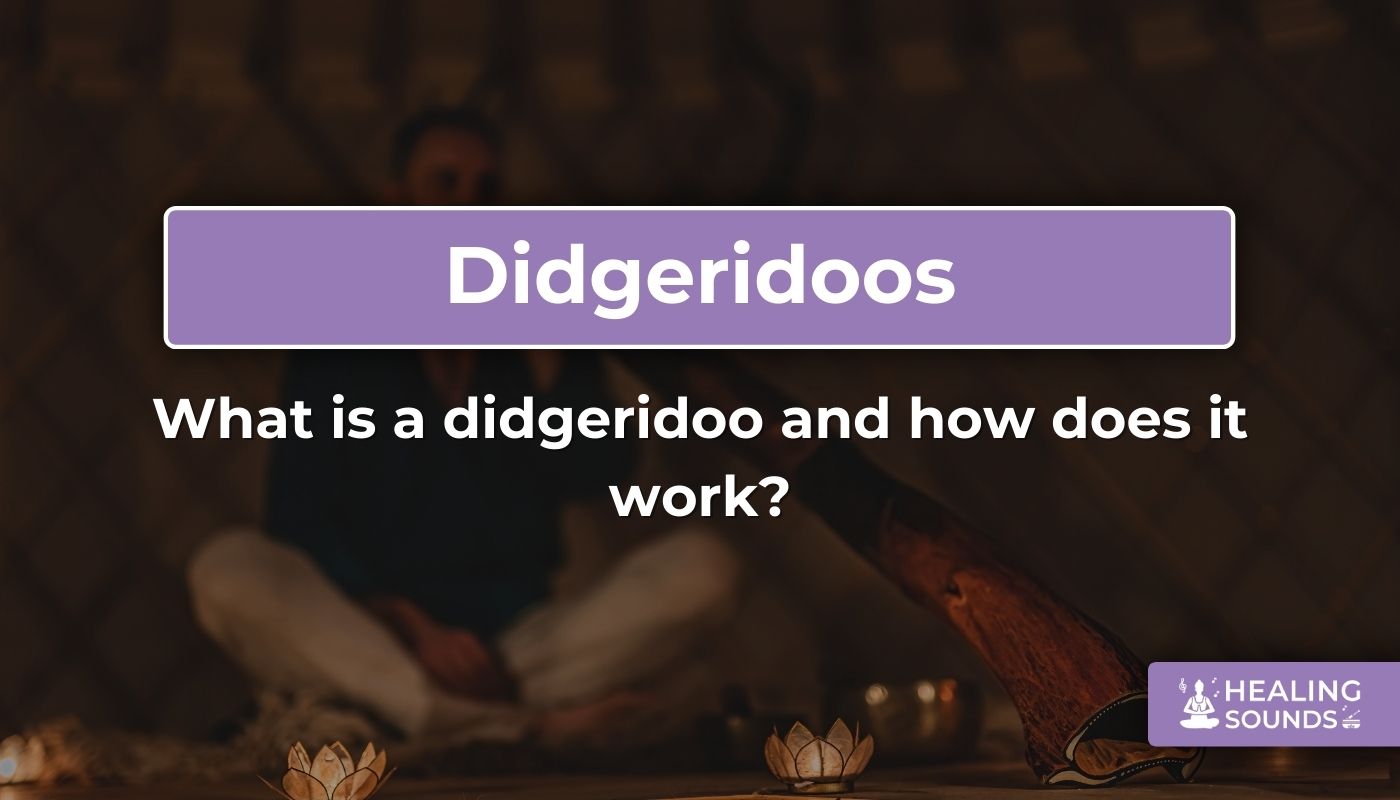Le didgeridoo , instrument à vent emblématique d'Australie , résonne de sons qui semblent provenir de la terre ancestrale. Originaire des peuples aborigènes du nord de l'Australie, cet instrument captivant offre bien plus que de la musique ; il est porteur d'une profonde signification culturelle et de surprenants bienfaits pour le bien-être. Que vous soyez un mélomane attiré par des sonorités uniques, un explorateur culturel en quête de connexion ou une personne en quête de vibrations thérapeutiques, le didgeridoo a une histoire fascinante. Rejoignez-nous pour une plongée dans l'univers du didgeridoo , explorant ses origines, sa sonorité unique, son importance culturelle et son apport aux pratiques de guérison.
Qu'est-ce qu'un didgeridoo ?
Alors, qu'est-ce qu'un didgeridoo ? À la base, c'est un instrument à vent classé parmi les aérophones en cuivre. Traditionnellement, il s'agit d'un long tube en bois, souvent cylindrique ou conique, fabriqué à partir de feuillus spécifiques, principalement des eucalyptus originaires du nord de l'Australie. Sa simplicité de forme dissimule la complexité et la profondeur du son qu'il produit : un bourdonnement continu et résonnant, ponctué de motifs rythmiques et d'harmoniques.
La production sonore repose sur la vibration des lèvres du joueur contre l'embouchure (généralement recouverte de cire d'abeille pour plus de confort et d'étanchéité), tout en utilisant une technique de respiration spéciale appelée respiration circulaire . Cela permet un flux sonore continu, une caractéristique qui distingue le didgeridoo.
La fabrication d'un didgeridoo : traditionnel et moderne
Traditionnellement, les artisans aborigènes fabriquaient des didgeridoos à partir de troncs ou de branches d'eucalyptus creusés naturellement par les termites. Ce processus naturel de creusement produit une perce interne irrégulière, contribuant ainsi grandement au timbre et aux propriétés acoustiques uniques de l'instrument. Trouver le bon tronc creusé par les termites est un art en soi, exigeant une connaissance approfondie du milieu local.
Les didgeridoos modernes, tout en respectant souvent les formes traditionnelles, peuvent être fabriqués à partir de divers matériaux comme le bambou, le teck, l'agave, la fibre de verre ou même la fibre de carbone. Ces instruments contemporains offrent des qualités sonores, une durabilité et parfois une portabilité variées, rendant le didgeridoo accessible à un plus large éventail de musiciens et de contextes musicaux. Chez Healing Sounds, nous proposons des instruments fabriqués avec soin, respectant à la fois la tradition et l'innovation.

Didgeridoo, instrument australien de guérison par le son
179,90$ 249,90$
Découvrez la profonde sérénité du didgeridoo avec des sons riches et résonnants, idéaux pour la méditation, la relaxation et l'exploration de la guérison sonore.
Explorez ce didgeridoo de guérisonLe son unique du didgeridoo
Le son du didgeridoo est immédiatement reconnaissable : un bourdonnement profond et envoûtant, à la fois apaisant et surnaturel. Ce bourdonnement fondamental est produit par les lèvres vibrantes du joueur. Cependant, la véritable magie réside dans les couches sonores créées par diverses techniques.
Les musiciens manipulent leur langue, leurs joues, leur mâchoire et leur diaphragme pour créer des motifs rythmiques (souvent appelés « rythmes » ou « cycles »), des accents et des harmoniques. Des sons vocaux, comme des cris d'animaux, peuvent également être projetés à travers l'instrument, ajoutant texture et complexité. Le paysage sonore qui en résulte est riche, dynamique et profondément engageant, ce qui en fait un outil puissant en musicothérapie et en sonothérapie.
Maîtriser la respiration circulaire : la technique clé
La respiration circulaire est essentielle pour jouer efficacement du didgeridoo. Cette technique permet au joueur de maintenir un bourdonnement continu en inspirant par le nez tout en expirant l'air stocké dans les joues par la bouche et dans l'instrument. Elle requiert coordination et pratique, mais libère le son soutenu caractéristique de l'instrument.
Principes de base de la respiration circulaire :
- Gardez l'air dans vos joues.
- Maintenez le buzz des lèvres en exerçant une pression sur les joues.
- Inspirez rapidement par le nez tout en continuant à bourdonner.
- Revenez à l’utilisation de l’air provenant des poumons/du diaphragme.
- Répétez de manière transparente.
La maîtrise de la respiration circulaire est non seulement essentielle pour jouer, mais elle est également censée contribuer à certains des bienfaits pour la santé associés au didgeridoo.
Importance culturelle et respect
Le didgeridoo est bien plus qu'un simple instrument à vent australien ; c'est un élément essentiel de la musique et de la culture aborigènes , notamment pour les groupes de la Terre d'Arnhem, dans le nord de l'Australie, où ses origines remontent à au moins 1 500 ans. Sa fonction première était principalement cérémonielle, accompagnant les chants, les danses et les récits qui connectaient les individus à leurs ancêtres, à leur terre (Pays) et au Rêve (la conception aborigène de la création et de l'existence du monde).
Chaque région, clan et individu possède ses propres rythmes, histoires et protocoles associés au didgeridoo. Traditionnellement, son utilisation lors des cérémonies était souvent réservée aux hommes initiés, bien que les pratiques varient considérablement selon les groupes aborigènes.
Jouer du didgeridoo avec respect
Compte tenu de ses profondes racines culturelles, il est crucial d'aborder le didgeridoo avec respect. Bien que l'instrument soit aujourd'hui joué dans le monde entier, il est important de reconnaître ses origines aborigènes. Voici quelques points clés à considérer :
- Reconnaître la source : Reconnaître et respecter les peuples autochtones en tant que gardiens du didgeridoo.
- Évitez l’appropriation culturelle : utilisez l’instrument avec respect, en évitant la banalisation ou la fausse représentation de la culture autochtone.
- Comprendre les protocoles traditionnels : Sachez que dans certains contextes traditionnels, des protocoles spécifiques régissent la pratique du didgeridoo et le moment de sa pratique. Bien que jouer pour le plaisir personnel ou pour se soigner soit généralement accepté en dehors des contextes cérémoniels traditionnels, la connaissance du didgeridoo est essentielle. Pour en savoir plus sur son importance culturelle, consultez des sources fiables comme l' Institut australien d'études aborigènes et insulaires du détroit de Torres (AIATSIS) .
Bienfaits du didgeridoo pour la santé et le bien-être
Au-delà de sa valeur musicale et culturelle, la pratique du didgeridoo est reconnue pour ses bienfaits potentiels sur la santé et le bien-être. La pratique de la respiration circulaire et la vibration soutenue qu'elle entraîne sollicitent le système respiratoire et peuvent offrir plusieurs avantages.
Des études, comme celle publiée dans le British Medical Journal, suggèrent que la pratique régulière du didgeridoo peut renforcer les muscles des voies respiratoires supérieures, contribuant potentiellement à réduire le ronflement et les symptômes d'apnée obstructive du sommeil légère à modérée. La respiration profonde et contrôlée requise peut également favoriser la relaxation et la pleine conscience, à l'instar des pratiques de méditation et de yoga.
Didgeridoo pour la sonothérapie et la méditation
Les fréquences de résonance et le bourdonnement continu du didgeridoo en font un instrument populaire dans les pratiques de guérison sonore et de méditation. Les vibrations profondes, ressenties physiquement, favorisent potentiellement la relaxation, la réduction du stress et un sentiment de bien-être. Nombreux sont ceux qui trouvent le son ancrant et centrant, favorisant des états de méditation ou de relaxation plus profonds.
Découvrez notre collection de didgeridoo

149,90$
209,90$
Fabriqué en teck durable, ce didgeridoo est idéal pour les débutants souhaitant explorer les techniques fondamentales et la guérison par le son. En savoir plus ➔
Fabriqué en eucalyptus traditionnel, ce didgeridoo offre des sonorités authentiques, idéales pour les séances de yoga, la méditation et la sonothérapie. En savoir plus ➔

199,90$
279,90$
Ce didgeridoo en bois torréfié de qualité professionnelle offre une résonance et une clarté tonale supérieures pour une performance et un travail sonore profond. En savoir plus ➔
Le didgeridoo est-il l’instrument le plus ancien ?
Si le didgeridoo est indéniablement ancien, des représentations rupestres suggérant son utilisation depuis des milliers d'années, il est complexe de déterminer quel est l'instrument le plus ancien. Des flûtes en os trouvées en Europe remontent à des dizaines de milliers d'années. Cependant, le didgeridoo est souvent considéré comme l'un des plus anciens instruments à vent encore joués aujourd'hui, témoignant d'une lignée continue de pratiques musicales et culturelles remontant à des millénaires.
Sa longévité en dit long sur son pouvoir et son importance durables au sein de la culture aborigène et sur son attrait croissant dans le monde entier.
Choisir son didgeridoo
Le choix d'un didgeridoo dépend de vos intentions : débutant, à la recherche d'un son thérapeutique, ou musicien ? Tenez compte de facteurs tels que le matériau (qui influence le timbre et la durabilité), la longueur et la tonalité (qui influencent la hauteur et la facilité de jeu) et la contre-pression (la résistance offerte par l'instrument, qui influence la respiration circulaire et le volume).
Conseils pour choisir un didgeridoo :
- Débutants : Les tonalités moyennes (comme Ré ou Do) et une contre-pression modérée sont souvent plus faciles à utiliser pour débuter. Des matériaux comme le bambou ou le teck peuvent être un bon point de départ.
- Guérison par le son : Privilégiez les instruments aux sons clairs et résonnants, ainsi qu'un bon transfert vibratoire. L'eucalyptus ou certains bois durs sont souvent privilégiés.
- Portabilité : envisagez des didgeridoos en plusieurs parties ou plus courts si le voyage est un facteur.
- Écoutez : si possible, écoutez des échantillons sonores ou essayez des instruments pour trouver un ton qui résonne avec vous.
Chez Healing Sounds, nous proposons une sélection organisée pour vous aider à trouver l'instrument qui convient le mieux à votre parcours.
Conclusion
Le didgeridoo est un instrument profondément lié à une culture ancestrale, une voix musicale unique et un outil de bien-être potentiel. De ses origines aborigènes d'Australie, issu de l'eucalyptus creusé par les termites, à sa présence moderne sur les scènes internationales et dans les milieux thérapeutiques, le didgeridoo continue de fasciner et d'inspirer. Son bourdonnement profond, obtenu grâce à la pratique consciente de la respiration circulaire , invite joueurs et auditeurs à un état de concentration. Que vous recherchiez la compréhension culturelle, l'expression musicale ou le pouvoir réparateur du son, le didgeridoo offre une voie riche et enrichissante. Explorez la gamme variée de didgeridoos de qualité chez Healing Sounds et trouvez l'instrument qui résonne avec votre esprit.
Questions fréquemment posées sur le didgeridoo
Traditionnellement, dans certains contextes culturels aborigènes d'Australie, le didgeridoo était souvent joué par des hommes initiés lors de cérémonies. Les protocoles varient considérablement selon les groupes aborigènes. En dehors de ces contextes cérémoniels traditionnels spécifiques, l'instrument est aujourd'hui largement joué par des personnes de tous horizons et de tous genres dans le monde entier. Cependant, il est essentiel de jouer dans le respect de ses origines aborigènes.
À l'origine, le didgeridoo servait principalement à des fins cérémonielles dans les cultures aborigènes d'Australie. Il accompagnait les chants, les danses et les récits, reliant les peuples à leur terre, à leurs ancêtres et au Rêve. Ses sonorités imitaient souvent la nature et étaient porteuses d'une profonde signification spirituelle.
Bien que très ancien, avec des preuves suggérant des milliers d'années d'utilisation, il est difficile de qualifier définitivement le didgeridoo d'instrument le plus ancien. Les flûtes en os retrouvées en Europe sont bien plus anciennes. Cependant, le didgeridoo est considéré comme l'un des plus anciens instruments à vent encore en usage aujourd'hui.
Bien que structurellement tubulaire, le didgeridoo est bien plus que cela. Ses dimensions spécifiques, le matériau dont il est fait (notamment la perce irrégulière des instruments traditionnels en eucalyptus) et les techniques de jeu (comme la respiration circulaire et les vocalisations) contribuent à sa sonorité unique et complexe, ainsi qu'à sa signification culturelle. C'est un instrument acoustique sophistiqué, et non un simple tube.
Traditionnellement, les didgeridoos sont fabriqués à partir d'essences spécifiques de bois dur d'eucalyptus, creusé naturellement par les termites dans le nord de l'Australie. Les didgeridoos modernes peuvent être fabriqués à partir de divers matériaux, notamment d'autres bois comme le bambou ou le teck, ainsi que des matériaux synthétiques comme la fibre de verre ou la fibre de carbone.


